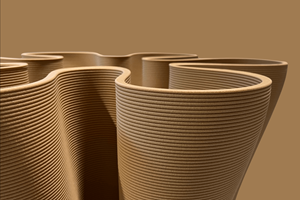Why CFRP?
There is no technology that can help automakers reach their lightweighting goals faster than carbon fiber-reinforced plastics.
Rocky Mountain Institute’s (Telluride, Colo.) cofounder, chairman and chief scientist, Amory Lovins, long a proponent of composites-intensive — and particularly carbon-composite-intensive — vehicles, once said, “There are perfectly valid light-metal and ultralight-steel solutions, and the market will sort out which materials win for what uses. But broadly speaking, I don’t think metal solutions offer the same strategic advantages to automakers as composites solutions using new technologies, which — when scaled and mature — seem to offer aerospace performance at automotive cost and speed.”
He was, and is, right: There is no technology that can help automakers reach their lightweighting goals faster than carbon fiber-reinforced plastics (CFRP). Long used in Formula 1 racing and other extreme sports, carbon composites are unparalleled in their ability to reduce mass, facilitate sleek, aerodynamic shapes, reduce tooling investment, eliminate corrosion and denting, improve sound damping and vibration, and protect occupants even in high-speed crashes.
The value proposition
Carbon fiber’s main attraction is its strength-to-weight ratio, which is 20 percent the mass of steel yet equally stiff and strong. Studies from Oak Ridge National Laboratory (ORNL, Oak Ridge, Tenn.) show that replacing today’s steel body-in-white (BIW) with an integrated carbon-composite structure could net up to a 60 percent mass reduction, boosting fuel efficiency by as much as 30 percent via mass decompounding: A lighter vehicle body makes it possible to reduce the cost and robustness of everything from hardware to brakes to engines with no loss in performance. This is critically important not only for meeting new fuel-economy standards with conventional internal-combustion engines, but to offset added weight from electric battery packs, fuel-cell storage cylinders and other equipment essential to alternative-powertrain vehicles.
Safety is clearly a concern, especially in small cars. Composites offer the highest specific-energy absorption of all major structural materials. CFRP crush cones and similar energy-absorbing structures can absorb ~120 kJ/kg of energy if made with a thermoset matrix (e.g., epoxy) or ~250 kJ/kg in a thermoplastic matrix vs. ~20 kJ/kg for steel, according to 2002 work published by Herrmann, Mohrdieck and Bjekovic of then DaimlerChrysler.
Although CFRP can offer 50 to 60 percent mass reduction vs. similar components in steel, the cost is 2 to 10 times higher when both materials and processing costs are considered, according to William F. Powers in Advanced Materials and Processes (May 2000, pp. 38-41). To put this in perspective, Powers reports that glass-reinforced composites reduce mass by 25 to 35 percent at costs on par with or slightly higher (1.5 times) than steel: magnesium offers a 60 to 75 percent mass reduction at 1.5 to 2.5 times greater cost and aluminum reduces mass by 40 to 60 percent at 1.3 to 2 times higher cost. These are not inconsequential differences.
Precursor possibilities
Unfortunately, 51 percent of the cost of carbon fiber is directly tied to the cost of polyacrylonitrile (PAN), rayon, and petroleum pitch precursors. That, in turn, is tied to the cost of oil. Much work (public and private) is underway to find less costly alternatives. The U.S. Department of Energy (DoE), ORNL and the Automotive Composites Consortium (ACC) are working on a multiyear study to improve automotive fuel efficiency. Baseline studies indicate that even if current commercial carbon fiber production processes were scaled up for passenger car production, conventional carbon fiber would still cost $8/lb. Research efforts, therefore, are focused on developing alternative precursors (such as renewable lignin) and alternative processing technologies (e.g., advanced oxidation reactors and microwave-assisted plasma technologies), which they believe will reduce carbon fiber production costs to $5/b to $7/lb.
Related Content
Infinite Composites: Type V tanks for space, hydrogen, automotive and more
After a decade of proving its linerless, weight-saving composite tanks with NASA and more than 30 aerospace companies, this CryoSphere pioneer is scaling for growth in commercial space and sustainable transportation on Earth.
Read MoreSulapac introduces Sulapac Flow 1.7 to replace PLA, ABS and PP in FDM, FGF
Available as filament and granules for extrusion, new wood composite matches properties yet is compostable, eliminates microplastics and reduces carbon footprint.
Read MoreWelding is not bonding
Discussion of the issues in our understanding of thermoplastic composite welded structures and certification of the latest materials and welding technologies for future airframes.
Read MoreCarbon fiber, bionic design achieve peak performance in race-ready production vehicle
Porsche worked with Action Composites to design and manufacture an innovative carbon fiber safety cage option to lightweight one of its series race vehicles, built in a one-shot compression molding process.
Read MoreRead Next
Q&A Forum: Automotive Composites
How will fiber-reinforced polymers fare in a post-recession, cost- and fuel-economy-obsessed auto market?
Read MoreScaling up, optimizing the flax fiber composite camper
Greenlander’s Sherpa RV cab, which is largely constructed from flax fiber/bio-epoxy sandwich panels, nears commercial production readiness and next-generation scale-up.
Read MoreCutting 100 pounds, certification time for the X-59 nose cone
Swift Engineering used HyperX software to remove 100 pounds from 38-foot graphite/epoxy cored nose cone for X-59 supersonic aircraft.
Read More











